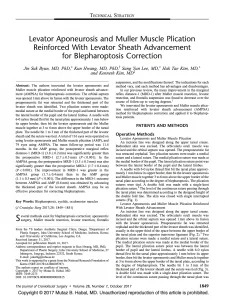Ptosis repair is largely performed simultaneously with suture or incision technique double eyelid surgery. The surgery takes place under local anesthesia, with or without oral sedatives. The duration of the surgery will depend on the severity of the ptosis. The skin stitches will be removed 5-7 days after the surgery at our office. The critical swelling will subside in 1 week, and the remaining swelling will gradually subside within 8-12 weeks.
Ptosis Repair
 Ptosis is known as an eyelid condition characterized by weakness in the eye elevating muscle. Usually, people who suffer from ptosis have droopy eyelids, often making the patients appear sleepy, tired and even harsh. The droopy eyelids hinder the amount of color aspect shown in the eyes, making them appear exhausted. This operation is necessary for many Asian patients whether they are elderly, or patients who seek a more radiant and vibrant appearance. There are also a handful of patients who have undergone inadequately performed double eyelid surgeries, and thus need revision to their asymmetric eyes.
Ptosis is known as an eyelid condition characterized by weakness in the eye elevating muscle. Usually, people who suffer from ptosis have droopy eyelids, often making the patients appear sleepy, tired and even harsh. The droopy eyelids hinder the amount of color aspect shown in the eyes, making them appear exhausted. This operation is necessary for many Asian patients whether they are elderly, or patients who seek a more radiant and vibrant appearance. There are also a handful of patients who have undergone inadequately performed double eyelid surgeries, and thus need revision to their asymmetric eyes.
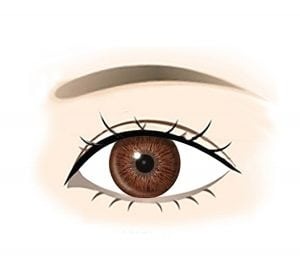
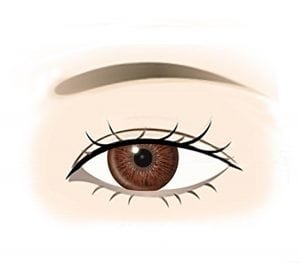
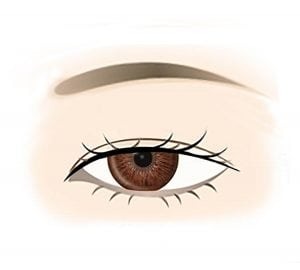
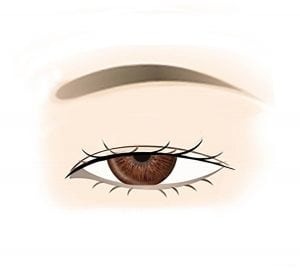
This disorder can affect one eye or both. Ideally, the lid position should allow 80 to 90% of the color aspect of the eye (iris) to be visible. In most cases, a patient showing anything less is considered to have ptosis. Some physical problems associated with this disorder are headaches due to eye and brow strain, inability to read for prolonged periods of time, as well as forehead wrinkles. These symptoms are related to patients with severe ptosis. However, patients with mild to moderate ptosis do not exhibit these symptoms apart from forehead wrinkles. Patients with mild ptosis may appear tired while those with moderate ptosis have a harsh appearance.
Types of Ptosis
There are two main types of ptosis–congenital ptosis and acquired ptosis (also referred to as senile ptosis). The two types of ptosis are not mutually exclusive of the other. The spectrum of the type of ptosis a patient can have can range from borderline to severe or in some cases a combination of the two. A skilled surgeon must be able to distinguish such differences in order to correctly diagnose patients and determine the most suitable surgical technique for the ptosis correction.
CONGENITAL PTOSIS
Congenital ptosis is due to an intrinsic muscle disorder. This disorder results in cellular degeneration and fat infiltration of the eye muscle responsible for raising the eyelid.
ACQUIRED PTOSIS
Acquired ptosis typically develops in elderly adults, but there have been cases where it has developed in patients even in their early 30s. Many of these patients begin to notice a decrease in the size of their eyes mainly due to drooping eyelids. Unlike congenital ptosis, acquired ptosis can be due to severe tearing and stretching of the levator muscle.
Ptosis Severity
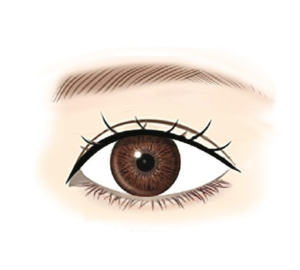
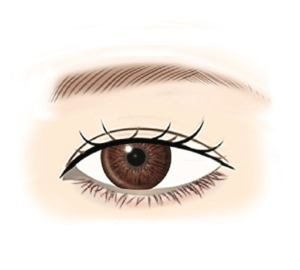
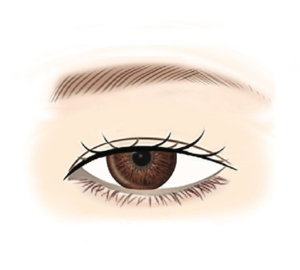
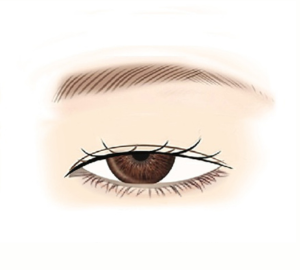
Mild Ptosis (1–2 mm droop)
Cases of mild ptosis generally only are a cosmetic concern. The pupil and most of the iris tend to remain visible, allowing the eye to maintain its full visual field. However, the appearance can be affected significantly still, leading to a fatigued or sleepy appearance. Should not interfere with daily activities, but its effects on confidence in one’s appearance can still impact quality of life.

Depending on the cause of mild ptosis, the condition can progress if there is additional weakening or damage to the eyelid’s muscles or the nerves that innervate them.

Corrective surgery restores an alert appearance, addressing and alleviating cosmetic concerns.
Moderate Ptosis (3–4 mm droop)
Moderate ptosis demonstrates more pronounced drooping of the upper eyelid. The upper part of the iris is usually obscured, and part of the pupil may begin to be covered as well, reducing the total field of vision.



Patients may not be able to open the eyelid fully, and many individuals must use conscious effort to keep their eyelid open enough to improve vision. In cases of moderate ptosis, patients will have a cosmetic impact, but the condition may also begin interfering with certain activities (e.g., reading, driving, focusing on a screen).
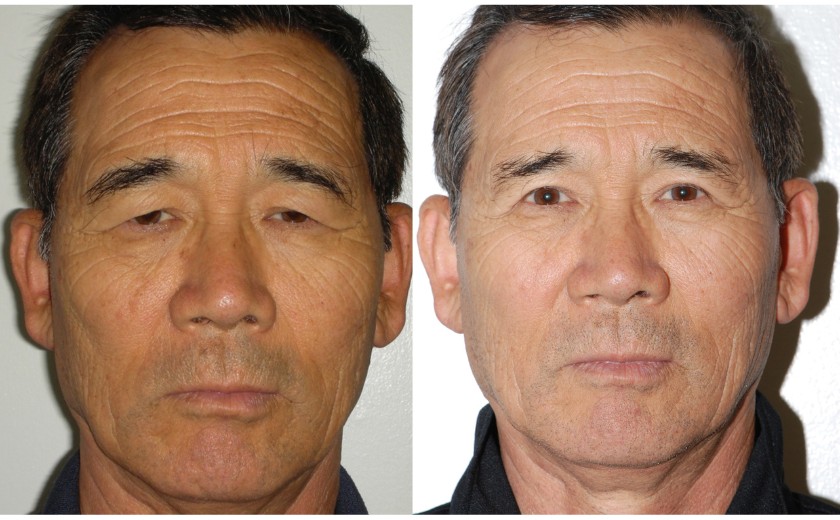
Corrective surgery results in a more alert appearance for the patient and a restored field of vision (when needed).
Severe Ptosis (> 4 mm droop)
Once patients experience severe ptosis, they will likely begin noticing significant interference in their daily lives. Much of the pupil becomes obscured and even fully covered by the eyelid in some cases, resulting in notable impairment of the visual field.
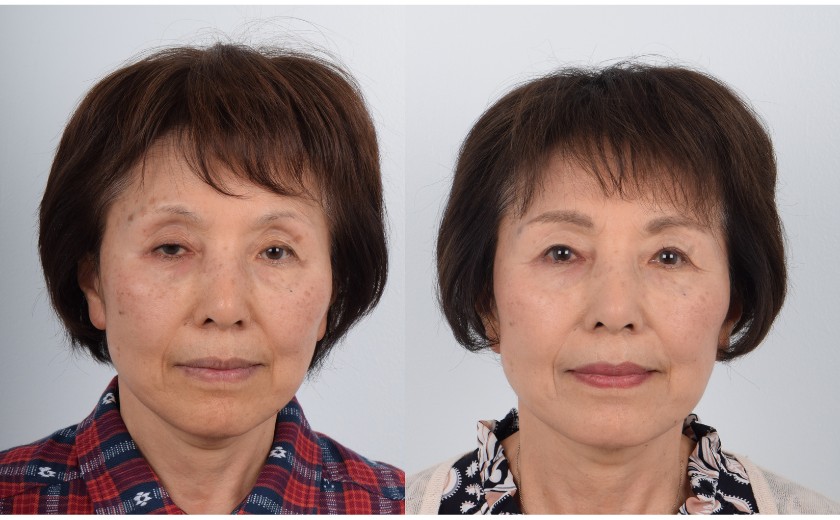
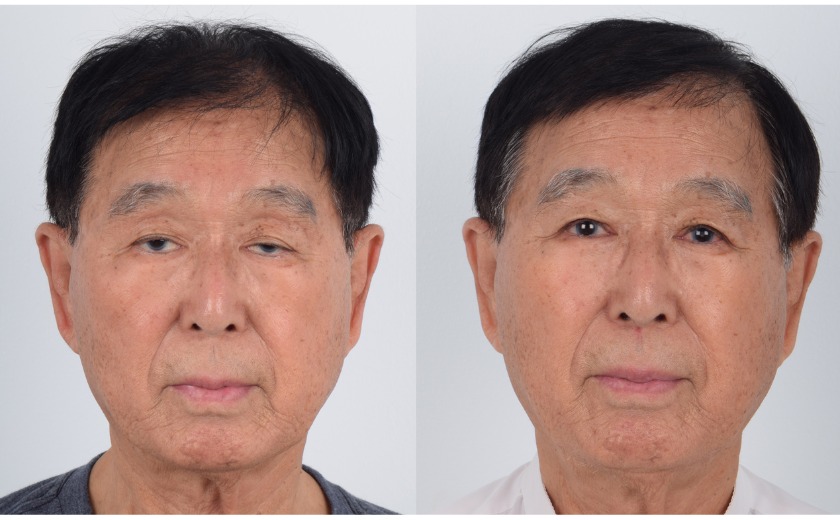
Patients may need to use their hands or make a concerted effort to open their eyelids enough to accomplish daily tasks such as cooking, reading, or driving. Patients are highly recommended to pursue corrective surgery for severe ptosis to restore day-to-day functionality and safety.
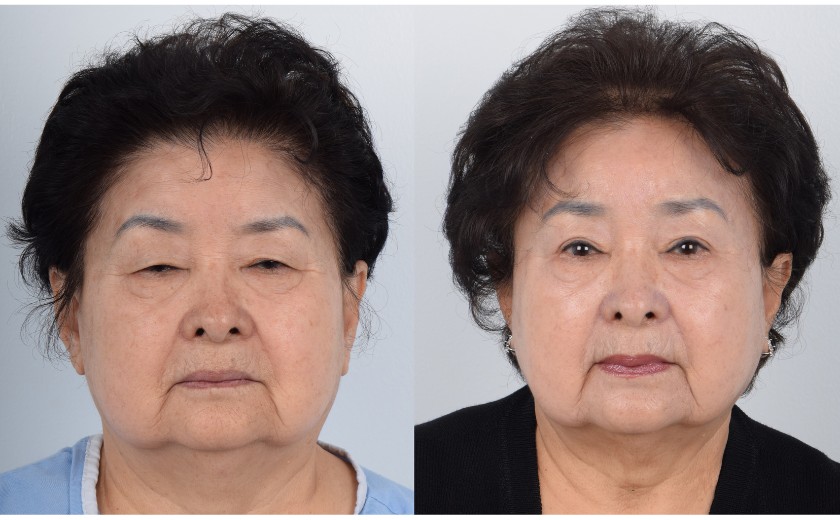
We provide ptosis repair for all levels of the condition, adapting the method used according to ptosis severity.
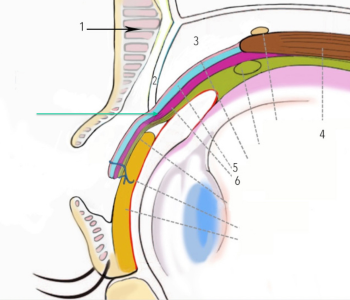
About Ptosis Repair
Vertical eye enlargement increases the amount of color aspect of the eyes that is shown to correct sleepy eyes.
Vertical eye enlargement widens the eye vertically so as to remove any upper visual obstruction experienced by the patient due to weak eyelid elevating muscle. There are two conventional methods to achieve a vertically enlarged eye. The first method is double eyelid surgery, or Asian eyelid surgery. The second method is called upper blepharoplasty, which involves removal of excess skin on the upper eyelid.
The basic principle of double eyelid surgery is the anchoring of the eyelid skin to the eye elevating muscle. By doing this, additional weight is placed on the eye elevating muscle. Ptosis patients, due to their weaker eye muscle, cannot tolerate this additional weight placed on their eye elevating muscle (levator aponeurosis). Therefore, prior to undergoing double eyelid surgery or revision double eyelid surgery, it is imperative this condition be diagnosed and corrected at the time of surgery. Otherwise, patients will not get the best results that they desire.
Despite the conventional methods described, the most effective method is a very complex procedure called ptosis repair. This process involves tightening of the muscle that elevates the upper eyelid, or the eye elevating muscle so that it has more power and effectiveness in opening the eyes.
The tightening process concerns a fragile area with many layers of fine tissue and a considerable amount of blood vessels. It also requires the surgeon’s ability to gauge how much tightening or loosening is required on the eye elevating muscle. Dr. Kim has successfully executed numerous ptosis repair surgeries for various purposes. He performs them regularly for elderly patients who experience visual obstruction due to excessive eyelid hooding, and for patients who need it for double eyelid surgery.
Before and After Photos

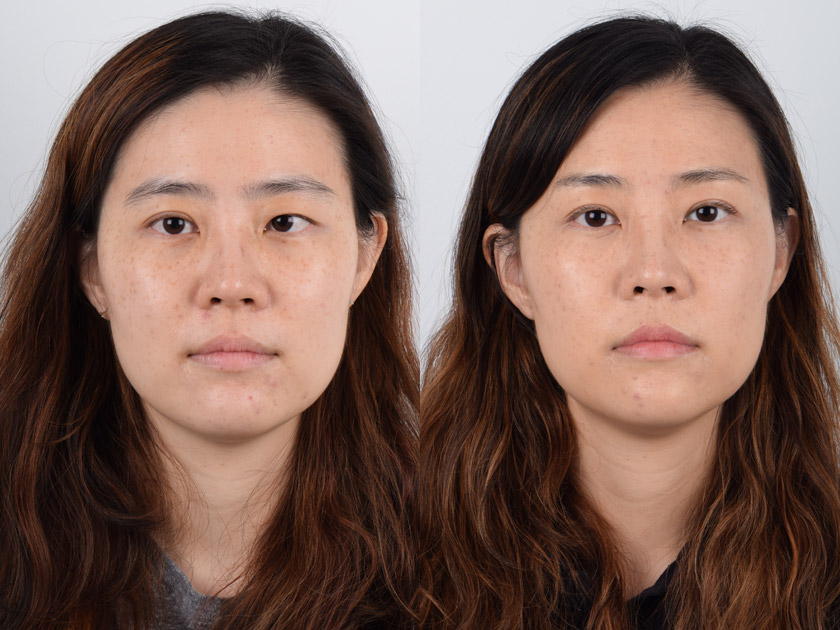
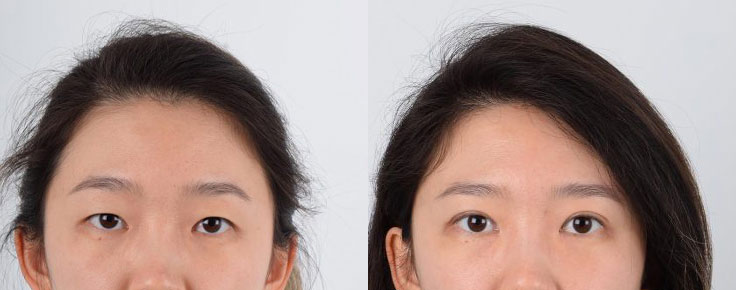
Reasons for Ptosis Correction
There are three main reasons ptosis correction is required. One is for aesthetic reasons. Patients with ptosis have their eyelids positioned below the ideal height and tend to look harsh and unfriendly. Therefore, it can hamper their day-to-day interactions with other people as a result of insecurities associated with how they appear. Another reason is dysfunctionality of their eyes, as patients who suffer from ptosis have difficulty opening their eyes and are forced to strain their brows and wrinkle their forehead. Lastly, patients seeking double eyelid surgery must undergo ptosis correction.
Anatomy of the Eye and Ptosis
There are two muscles that are responsible for raising or elevating the eyelid—the levator muscle and the Müller’s muscle. The levator muscle is a more superficial muscle and sits above the Müller’s muscle. These two muscles work in concert to lift the eyelid. The levator muscle is controlled by voluntary signaling, whereas the Müller’s muscle is controlled by involuntary signaling.
In mild to moderate cases, ptosis surgery can be performed with correction of Müller’s muscle only. In patients with acquired ptosis, correction requires the strengthening of the levator muscle or the Müller’s muscle. In this case, determining which muscle to correct is based on which muscle is dysfunctional.
Types of Ptosis Repair
Non-incisional ptosis correction is especially useful when the patient has had prior eyelid surgery, and would like to avoid having further incisions.
Non-incisional ptosis correction method can be useful for patients with borderline ptosis. This involves flipping the eyelid and working on the inner, deep aspect of the eyelid. The result is less traumatic to the eyelid tissue since less additional surgical incision is made. It is also helpful in creating the most natural and dynamic double eyelid fold, as the anatomy that is involved in fold formation is not disturbed.
An advancement with ptosis correction for severe ptosis involves simultaneously tightening both muscles to provide maximal eyelid functionality and durability to the ptosis repair compared to the prior method. Another advancement with severe ptosis is coupling the eye elevating muscle to the superior rectus muscle. The advantage of this technique, compared to the traditional method of elevating to the forehead, is that the eyelid mechanism is significantly more natural.
Challenges
Ptosis can negatively affect the function of one’s eye(s) and one’s appearance.
Ptosis correction is an extremely challenging surgery, as it requires the patient to be fully conscious and cooperative. Thus, patients are given only local anesthesia. During correction, the patient must lift their eyes and also sit upright to determine how much weight from soft tissue is impinging the eye elevation. The surgeon must also be careful not to induce excess or asymmetric swelling during surgery; this is done only by very meticulous dissection. Furthermore, excess bleeding must also be avoided by careful dissection and avoidance of the many fine vessels. Therefore, it is equally important that your surgeon is skilled and understands the procedure thoroughly.
Ptosis or subclinical ptosis (i.e., no evidence of ptosis but results after double eyelid surgery) can also be an issue for patients who wish to undergo double eyelid surgery. When seeking ptosis correction, do your research to find a skillful and experienced surgeon.
Procedure
About Droopy Eyelid Correction
When an eyelid hangs improperly, it can cause aesthetic issues, discomfort, vision problems, and irritation. Your eyes dry out more easily when the lids droop away from the cornea. These problems are all treatable with the proper surgical strategy.
DROOPY LOWER EYELIDS

DROOPY UPPER EYELIDS
Blepharoptosis is a muscular disorder in which the upper eyelids are too weak to fully support their own weight. Most eyelids only hang down one to two millimeters from the top of the cornea. People with blepharoptosis, however, have upper lids that droop even further, often impeding their vision.[2] When the upper eyelids contain excess skin, this is a condition called dermatochalasis. The symptoms of dermatochalasis are often similar to blepharoptosis, causing the upper eyelids to block one’s vision. Dr. Kim can correct either condition with precision, care, and diligence.
If you are struggling with droopy eyelids, Dream Medical Group is here to help. Schedule a consultation at our Los Angeles office and tell us how we can help alleviate your cosmetic frustrations and/or health concerns.
The Benefits of Droopy Eyelid Corrective Surgery
When you experience eyelid enhancement, your whole world opens up. Droopy lids may cause impaired vision, a saggy expression, and overall unhappiness with one’s appearance. By tightening and lifting the look of your lids, Dr. Kim and his associates can restore your youthful expression and reduce the complications related to droopy eyes.
Ideal Eyelid Surgery Candidates
If you are a healthy individual who wishes to correct a droopy eyelid condition, then you may be a perfect candidate for corrective enhancement. Please inform the Dream Medical Group staff of any conditions you may have, including dry eye, detached retina, glaucoma, or any serious vision impairments.
Let’s start a conversation to cover any questions you may have and address all of your concerns. We are determined to provide you with the best eyelid care in Los Angeles.
Droopy Eyelid Procedure
Eyelids droop for different reasons and with varying degrees of severity. Dr. Kim will inspect your eyelids and suggest a course of action specific to your case. It is ideal for your iris to be 80-90% visible to others. When your upper eyelid hangs too low, it obstructs more of your iris. This is a condition known as ptosis. Individuals stricken with ptosis have trouble fully lifting their eyelids for a sustained amount of time due to weakened muscles. The experts at Dream Medical Group offer a Ptosis Repair procedure to support and lift the upper eyelid to its optimal position.

Regardless of your ethnicity, age, or gender identity, the experienced staff at Dream Medical Group will provide the utmost care and comfort during your procedure. After administering the appropriate anesthetic, your doctor will create any necessary incisions with an eye for aesthetics. We want to hide those scars, no matter how tiny they might be! The duration of your procedure depends on the nature of your droopy eyelid correction.
Recovery from Eyelid Surgery for Ptosis
You may experience minor swelling or sensitivity following an eyelid cosmetic procedure. This is completely normal, but please do not hesitate to ask for assistance from a medical professional at Dream Medical Group. Please avoid direct contact with sunlight and wear protective UV sunglasses when you go outside. Most blepharoplasty surgeries require between one and two weeks for a full recovery, but each case is unique.
Schedule Your Personal Consultation in Los Angeles
He also looks forward to hearing your input so you can progress to the next step in your eyelid evolution. To learn more about Dr. Kim and his team prior to your appointment, please visit our Blog. We appreciate the opportunity to communicate directly with our readers, and look forward to connecting with you one-on-one during your consultation.
Medical Publications
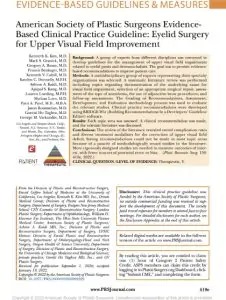 American Society of Plastic Surgeons Evidence- Based Clinical Practice Guideline: Eyelid Surgery for Upper Visual Field Improvement
American Society of Plastic Surgeons Evidence- Based Clinical Practice Guideline: Eyelid Surgery for Upper Visual Field Improvement
Received for publication September 1, 2020; accepted January 19, 2022.
Background: A group of experts from different disciplines was convened to develop guidelines for the management of upper visual field impairments related to eyelid ptosis and dermatochalasis. The goal was to provide evidence- based recommendations to improve patient care.
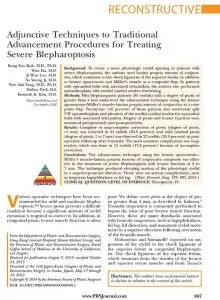
Plastic and Reconstructive Surgery, Vol. 133, No. 4
April 2014
The advancement technique using the levator aponeurosis–Müller’s muscle–lamina propria mucosa of conjunctiva composite was effective in the treatment of severe blepharoptosis with levator function of 2 to 7 mm. The technique produced elevating motion of the physiologic eyelid in a superior-posterior direction. There were no serious complications, such as long-term lagophthalmos or lid lag.
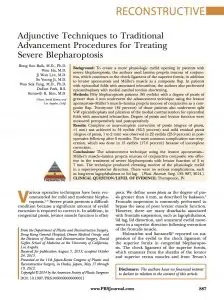
Plastic and Reconstructive Surgery, Vol. 130, No. 1
July 2012
It is very difficult to correct eyelid retraction caused by tissue fibrosis and muscle degeneration. Correction of the retraction by levator lengthening using the pretarsal tissue is simpler to execute, measurable during surgery, and easy to adjust, and offers high predictability in its result.
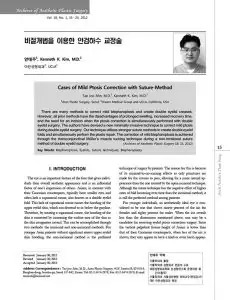
Archives of Aesthetic Plastic Surgery, Vol. 18, No. 1
2012
This article introduces the minimally invasive double eyelid surgical technique, in which a permanent suture is used in order to make the double eyelid crease and correct mild ptosis without making an incision. The advantages are minimal to no scarring, quick recovery time, and minimal trauma to the eyelid tissue. Lastly, the advantage of the present method is its technical simplicity and relatively short operating time.





